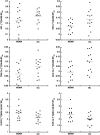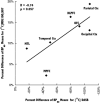Sustained recreational use of ecstasy is associated with altered pre and postsynaptic markers of serotonin transmission in neocortical areas: a PET study with [¹¹C]DASB and [¹¹C]MDL 100907
- PMID: 22353758
- PMCID: PMC3327851
- DOI: 10.1038/npp.2011.332
Sustained recreational use of ecstasy is associated with altered pre and postsynaptic markers of serotonin transmission in neocortical areas: a PET study with [¹¹C]DASB and [¹¹C]MDL 100907
Abstract
3,4-Methylenedioxymethamphetamine (MDMA), the main psychoactive component of the recreational drug ecstasy, is a potent serotonin (5-HT) releaser. In animals, MDMA induces 5-HT depletion and toxicity in 5-HT neurons. The aim of this study was to investigate both presynaptic (5-HT transporter, SERT) and postsynaptic (5-HT(2A) receptor) markers of 5-HT transmission in recently abstinent chronic MDMA users compared with matched healthy controls. We hypothesized that MDMA use is associated with lower SERT density and concomitant upregulation of 5-HT(2A) receptors. Positron emission tomography studies using the SERT ligand [¹¹C]DASB and the 5-HT(2A) receptor ligand [¹¹C]MDL 100907 were evaluated in 13 current and recently detoxified MDMA users and 13 matched healthy controls. MDMA users reported a mean duration of ecstasy use of 8 years, regular exposure, and at least 2 weeks of abstinence before the scans. SERT and 5-HT(2A) receptor availability (binding potential, BP(ND)) were analyzed with a two-tissue compartment model with arterial input function. Current recreational MDMA use was significantly associated with lower SERT BP(ND) and higher 5-HT(2A) receptor BP(ND) in cortical, but not subcortical regions. Decreased SERT BP(ND) was regionally associated with upregulated 5-HT(2A) receptor BP(ND). In light of the animal literature, the most parsimonious interpretation is that repeated exposure to MDMA in humans, even in moderate amounts, leads to damage in 5-HT neuron terminals innervating the cortex. Alterations in mood, cognition, and impulse control associated with these changes might contribute to sustain MDMA use. The reversibility of these changes upon abstinence remains to be firmly established.
Figures




Similar articles
-
In vivo imaging of cerebral serotonin transporter and serotonin(2A) receptor binding in 3,4-methylenedioxymethamphetamine (MDMA or "ecstasy") and hallucinogen users.Arch Gen Psychiatry. 2011 Jun;68(6):562-76. doi: 10.1001/archgenpsychiatry.2011.56. Arch Gen Psychiatry. 2011. PMID: 21646575
-
The 5-HT(2A) receptor and serotonin transporter in Asperger's disorder: A PET study with [¹¹C]MDL 100907 and [¹¹C]DASB.Psychiatry Res. 2011 Dec 30;194(3):230-234. doi: 10.1016/j.pscychresns.2011.04.007. Epub 2011 Nov 12. Psychiatry Res. 2011. PMID: 22079057 Free PMC article.
-
Positron emission tomographic studies of brain dopamine and serotonin transporters in abstinent (+/-)3,4-methylenedioxymethamphetamine ("ecstasy") users: relationship to cognitive performance.Psychopharmacology (Berl). 2008 Oct;200(3):439-50. doi: 10.1007/s00213-008-1218-4. Epub 2008 Jul 27. Psychopharmacology (Berl). 2008. PMID: 18661256 Free PMC article.
-
Mood, cognition and serotonin transporter availability in current and former ecstasy (MDMA) users: the longitudinal perspective.J Psychopharmacol. 2006 Mar;20(2):211-25. doi: 10.1177/0269881106059486. J Psychopharmacol. 2006. PMID: 16510479 Review.
-
Neuroimaging research in human MDMA users: a review.Psychopharmacology (Berl). 2007 Jan;189(4):539-56. doi: 10.1007/s00213-006-0467-3. Epub 2006 Jul 18. Psychopharmacology (Berl). 2007. PMID: 16847678 Review.
Cited by
-
Repeated exposure to MDMA triggers long-term plasticity of noradrenergic and serotonergic neurons.Mol Psychiatry. 2014 Jul;19(7):823-33. doi: 10.1038/mp.2013.97. Epub 2013 Aug 20. Mol Psychiatry. 2014. PMID: 23958955
-
Behavioral and Serotonergic Changes in the Frontal Cortex Following Methamphetamine Self-Administration.Int J Neuropsychopharmacol. 2018 Aug 1;21(8):758-763. doi: 10.1093/ijnp/pyy044. Int J Neuropsychopharmacol. 2018. PMID: 29762664 Free PMC article.
-
fNIRS suggests increased effort during executive access in ecstasy polydrug users.Psychopharmacology (Berl). 2015 May;232(9):1571-82. doi: 10.1007/s00213-014-3795-8. Epub 2014 Nov 14. Psychopharmacology (Berl). 2015. PMID: 25391436
-
Meta-analysis of molecular imaging of serotonin transporters in major depression.J Cereb Blood Flow Metab. 2014 Jul;34(7):1096-103. doi: 10.1038/jcbfm.2014.82. Epub 2014 May 7. J Cereb Blood Flow Metab. 2014. PMID: 24802331 Free PMC article.
-
Integrated treatment of substance use and psychiatric disorders.Soc Work Public Health. 2013;28(3-4):388-406. doi: 10.1080/19371918.2013.774673. Soc Work Public Health. 2013. PMID: 23731427 Free PMC article. Review.
References
-
- Abi-Dargham A, Martinez D, Mawlawi O, Simpson N, Hwang DR, Slifstein M, et al. Measurement of striatal and extrastriatal dopamine D1 receptor binding potential with [11C]NNC 112 in humans: validation and reproducibility. J Cereb Blood Flow Metab. 2000;20:225–243. - PubMed
-
- Abi-Dargham A, Zea-Ponce Y, Terriere D, Al-Tikriti M, Baldwin R, Hoffer P, et al. Preclinical evaluation of [I-123]R93274 as a SPECT radiotracer for imaging serotonin 5-HT2A receptors. Eur J Pharmacol. 1997;321:285–293. - PubMed
-
- Buchert R, Thomasius R, Nebeling B, Petersen K, Obrocki J, Jenicke L, et al. Long-term effects of ‘ecstasy' use on serotonin transporters of the brain investigated by PET. J Nucl Med. 2003;44:375–384. - PubMed
-
- Buchert R, Thomasius R, Petersen K, Wilke F, Obrocki J, Nebeling B, et al. Reversibility of ecstasy-induced reduction in serotonin transporter availability in polydrug ecstasy users. Eur J Nucl Med Mol Imaging. 2006;33:188–199. - PubMed
-
- Cahir M, Ardis T, Reynolds GP, Cooper SJ. Acute and chronic tryptophan depletion differentially regulate central 5-HT1A and 5-HT 2A receptor binding in the rat. Psychopharmacology (Berl) 2007;190:497–506. - PubMed
Publication types
MeSH terms
Substances
Grants and funding
LinkOut - more resources
Full Text Sources
Medical

